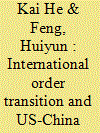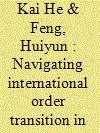| Srl | Item |
| 1 |
ID:
187400


|
|
|
|
|
| Summary/Abstract |
Challenging a popular view that China’s rise will lead the United States and China to fall into the ‘Thucydides trap’—a possible hegemonic war between the two—this paper proposes an ‘institutional peace’ argument, suggesting that the ongoing international order transition will be different from previous order transitions in history. Instead of using military means to change the international order, China and the United States have relied on various institutional balancing strategies to compete with one another for an advantageous position in the future international order. The discussion on the institutional competition between China and the US around the AIIB and the ARF-related multilateral security architecture supports the ‘institutional peace’ argument: institutional competition in the form of institutional balancing strengthens the dynamics and utility of international institutions, encourages states to offer new public goods, and could lead to a more peaceful order transition in the international system. However, this institutional peace argument is constrained by two caveats: the continued validity of the MAD nuclear deterrence and a limited degree of ideological antagonism between the US and China.
|
|
|
|
|
|
|
|
|
|
|
|
|
|
|
|
| 2 |
ID:
190662


|
|
|
|
|
| Summary/Abstract |
The world is changing, and the liberal international order (LIO) is at stake. Scholars and pundits hold different views on whether and how an order transition will take place. We argue that the divergent arguments around LIO are rooted in contested conceptualizations of what an international order is as well as the untheorized measure of what counts as a ‘transition’ of international order. We propose a synthesized and deductive approach to defining international order with three pillars: power, institutions, and norms. We argue that a significant order transition will take place when at least two pillars of the order are fundamentally challenged and eventually changed. Applying this deductive, three-pillar conceptual framework of international order, we preliminarily examine how US-China competition has impacted the current LIO in the Indo Pacific. We conclude that the multi-pillar feature of the international order technically strengthens the sustainability and resilience of the current LIO. Even though China’s rise might change the power distribution in the system—the power pillar of the order, the mere power shift between China and the United States will not lead to a significant order transition if the other two pillars of the order remain intact.
|
|
|
|
|
|
|
|
|
|
|
|
|
|
|
|
| 3 |
ID:
190661


|
|
|
|
|
| Summary/Abstract |
The world is in crisis. The Covid pandemic and the ongoing Russia-Ukraine war signify a potential order transition in the international system. The Indo Pacific is at the center of gravity of great power competition between the US and China. How have policy elites in the region perceived the potential order transition against the background of US-China strategic competition? How have states, including both great and secondary powers, chosen different strategies to cope with security and economic turbulence in the Indo Pacific? This special issue intends to shed some light on these questions by critically examining the diverse perceptions and policy choices of the United States, China, South Korea, India, Japan, Indonesia, and the UK during the period of potential order transition in the Indo Pacific. It provides an academic platform for scholars to engage in this ‘order transition’ topic from different theoretical perspectives as well as from respective national angles in the Indo Pacific. It suggests that the complexity of the international order itself has made the ‘order transition’ more complicated and difficult than before. It is the best of times, it is the worst of times, and it is the most challenging time for state leaders and scholars alike.
|
|
|
|
|
|
|
|
|
|
|
|
|
|
|
|